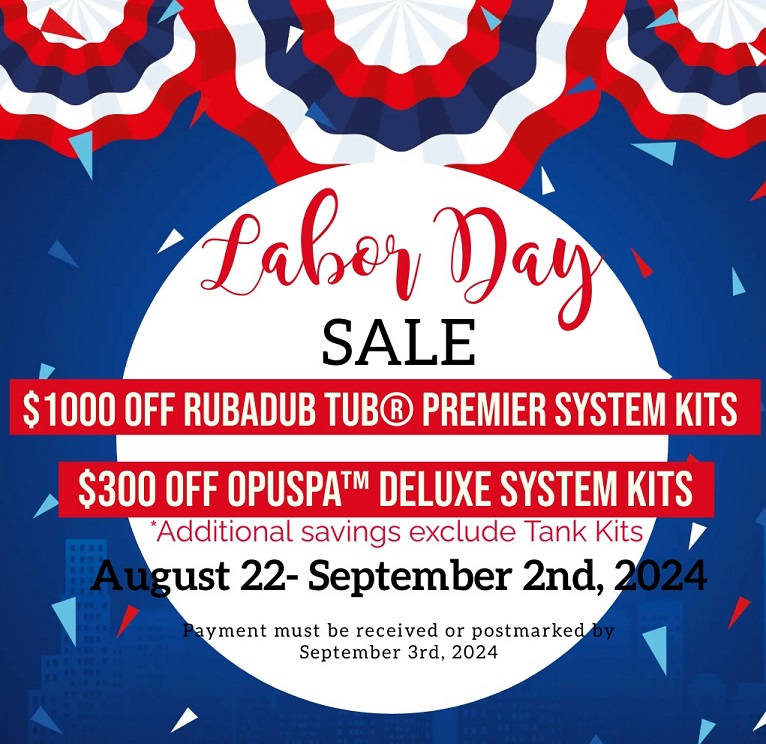How Long Does It Take To Heat Up And What Does It Cost?
We need to list some information so we can answer these questions accurately. We need to know the beginning water temperature, heater power, heat loss, surface area, heat retention, and final use temperature. Cost of operation depends on insulation, surface area, and energy cost. As you will see, it’s a little bit complicated.
Heater Power
Electric heaters come in three sizes: 1.5 kW (120V,15 Amp); 6 kW (240V,30 Amp); and 11.5 kW (240V,60 Amp). Each heater has a different rise rate. The following table compares rise rates:
| Typical Water Temperature Rise Rates (In Degrees Fahrenheit Per Hour) | |||||
| Spa/Tub Model | Max Gallons | 1.5KW 120V | 6KW 240V | 11.5KW 240V | Natural Gas* 100,000 BTU |
| Opu 4’ dia x 35” | 241 | 2.6 | 10.5 | 20.1 | 48.1 |
| Opu 5’ dia x 35” | 387 | 1.6 | 6.6 | 12.6 | 30.0 |
| Opu 6’ dia x 35” | 567 | 1.1 | 4.5 | 8.5 | 20.4 |
| Rub 4’ dia x 44” | 303 | 2.0 | 8.0 | 15.5 | 36.7 |
| Rub 5’ dia x 44” | 486 | 1.25 | 5.0 | 9.6 | 22.9 |
| Rub 6’ dia x 44” | 712 | 0.9 | 3.4 | 6.5 | 15.6 |
| Rub 7’ dia x 44” | 982 | 0.6 | 2.4 | 4.6 | 11.3 |
| Rub 8’ dia x 44” | 1,294 | — | 1.9 | 3.6 | 8.6 |
| *NOTE: For Propane, derate 12% | |||||
| Also see rise rates for our larger tubs: | |||||
| 6 kW (240V) Keeps water hot during use, even in winter. | |||||
Remarks
11.5 kW (240V) Used with large spas and hot tubs or in situations that require fast rise rates.
6 kW (240V) Keeps water hot during use, even in winter.
1.5 kW (120V) When the cover is off, water loses heat faster than the heater supplies it. The water cools quickly. This is only acceptable for short soaks or with smaller tubs.
Temperature Rise Rate Comparison Numbers
The rise rate on our 241-gallon hot tub is 20.1° per hour with an 11.5 kW heater, 10.5° per hour with a 6 kW heater, and only 2.6° per hour with the 1.5 kW heater.
An Example Using The Chart
Let’s assume you have a 241-gallon hot tub and your starting water temperature is 50° and you want to raise the temperature another 54° to 104°. Look up the heater you’ll be using on the chart. Divide 54° by that number. The result is the number of hours it will take that heater to raise the water temperature 54°.
So, if you divide 54 by 2.6, you get 20.77, rounded up to 28. That means it’ll take 28 hours to raise the water temperature to your desired 104°. If you use the next larger heater and you divide 54 by 10.5, you get 5.14. That means it’ll only take about 5 hours to reach 104°.
A Larger Heater May Require a Larger Circuit
You’ll find the 1.5 kW heater may take several days for the initial heat up. That is too long, which is why we don’t recommend this small heater. It seems that a 11.5 kW heater would be best, however that requires a 60 amp circuit and that is possible only when 150-200 amp service is available.
Commercial Installations
Usually, commercial establishments with extremely large spas and hot tubs use 11.5 kW heaters. As stated above, if you want this size heater, you need a 150-200 amp electrical service.
Residential Installations
It pays to install the right-sized heater. The best choice for most home spas and hot tubs is a 6 40V heater. Beware of 120V only plug-in spas. They have 1500 watt heaters which won’t heat your spa adequately. This would be like using a hair drier to heat up your hot tub! If you wish to leave the water at a constant temperature, it’s more economical to use an electric 6kW heater. While the 6kW heater is ideal for most tubs, you may want to reevaluate this if you are looking at an 8′ diameter or larger tubs or extra deep tubs.
Energy Efficiency Over Time
So, which installation is the most economical and energy-efficient to maintain – the deep, narrow hot tub (400-600 gallons) or the shallow wide spa (250 gallons). Many people think, “Of course, the spa! There’s more water to heat in a hot tub!” Not true! It’s correct that hot tubs have greater thermal mass (gallons of water) than spas and so they take longer to heat up. But, they retain heat longer. They take less energy to maintain your desired, constant temperature.
Surface Area And Heat Retention
We don’t pay to heat water! We pay to replace the heat that escapes out the top, sides, and bottom of the spa or tub. A typical five-foot diameter Rubadub Tub® has roughly 94 square feet of water surface area. A spa that seats the same number of people has at least 140 square feet of water surface area. Since a round hot tub has less water surface area than a square spa, less heat escapes from the top.
Water Volume And Heat Retention
The large volume of water in a Rubadub Tub® allows it to hold heat considerably longer than spa with a comparable volume of water. For example, consider an outdoor installation in the wintertime. If you lose electric power, the Rubadub Tub® retains enough heat to keep it from freezing for five to six days. A spa would lose its heat and freeze within a couple of days. It’s a matter of thermal mass – the larger the thermal mass, the slower it cools.
Danger To Pipes And Equipment
Even though the water in the hot tub won’t freeze quickly in the above situation, the pipes and equipment will! If you lose electric power, you must act quickly to prevent damage to your equipment. It’s best to drain the hot tub or spa during extended power outages in winter.
Should I Turn The Heater Off?
Most of the time, you shouldn’t turn your heater off. Hot tubs and spas are energy-efficient. Remember what we said about heater size and raise rates. You’re better off if you leave the heater on all the time, especially if your tub is outside. The thermostat will maintain the proper use temperature. This means no waiting. Your spa or hot tub will always be ready when you want to get in.
Isn’t It Cheaper To Heat With Gas?
Well, yes and no. Gas heaters aren’t often used in home spas and tubs for three reasons: 1. Up-front cost of the heater itself. 2. Outdoor winter use restrictions. 3. Indoor cost of modifications to chimneys and flues.
Up-Front Cost
Gas heaters are possible for home units, but they cost considerably more than electric heaters. You could pay $600-1,600 for the heater alone.
Inside vs. Outside
You shouldn’t use gas outdoors in the wintertime because gas heaters must be in a heated environment. Some dealers will install gas heaters outside, but every winter these heaters will freeze and cause damage to both the heater and the tub. Tub and spa warranties do not cover damage from freezing. Homeowner policies don’t either. Gas heaters belong indoors, just like your home furnace.
Chimneys And Flues
Many homes require modification to chimneys or flues to accommodate a gas heater. Installing a gas heater can mean new venting through the house all the way up to the roof. These modifications can easily cost another $1,000 or more. If you really want a gas heater, contact a building inspector or a heating and air conditioning contractor, who can advise you on the requirements for vent and combustion and tell you if your existing flue or chimney will be adequate.
Propane Costs
Running a propane gas hot tub heater, commonly used in cabins and some rural homes, costs about the same as electricity. We recommend using propane in remote areas where electricity is not available, or if you installed your tub in a cabin and can’t wait for the slower rise rates of electric heaters.
Large Heaters – Faster Heat Rise Times
Large propane heaters offer fast rise times of 20-30 degrees per hour depending on heater size and the number of gallons being heated. If the cabin has its hot tub heater installed outdoors or in a non-heated porch area, you won’t be able to use your tub year-round because of the same problems you have with any gas heater. You’ll get heat exchanger freeze-ups, pilot lights blowing out, and stiff controls that don’t operate properly.
How To Choose Between Electric Or Gas
Our Advice: If you can recover the cost of the heater and installation in 5-7 years and install the heater indoors, get the gas heater. However, if it’s going to take 10 to 20 years to recover installation costs and you’re only going to live in the house for 5 years, you’ve just lost the money. For most people, a 6 kW electric heater is the most practical..
Still Searching for the Perfect Hot Tub?
Great Northern® Hot Tubs
Crafting Cedar and Redwood Hot Tubs with Beauty, Functionality, and Efficiency Since 1975
©2003 – 2025 Great Northern. All Rights Reserved | Design By: Website Wizards

